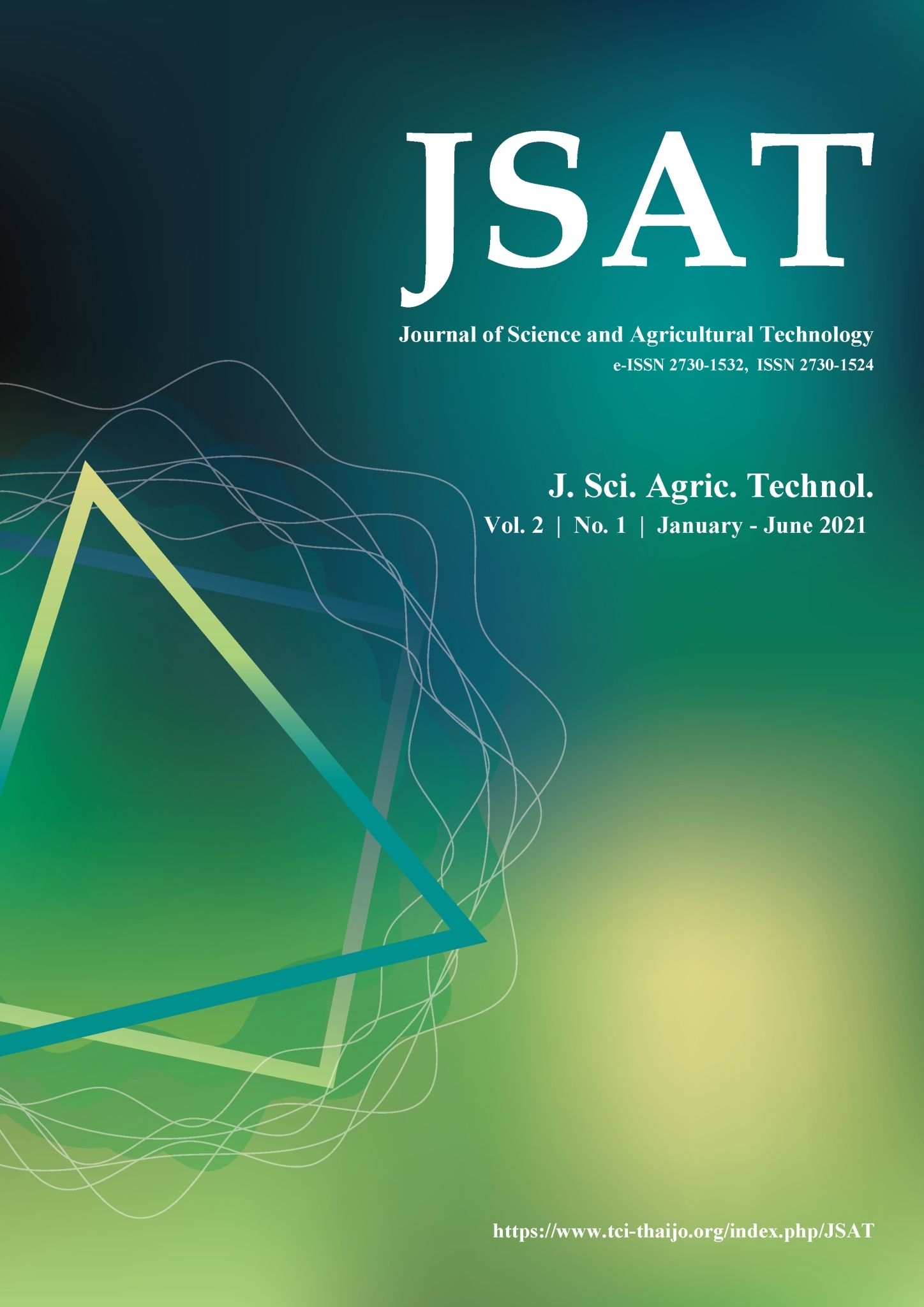Effect of wild yam root preparation on physiochemical properties of ready-to-use wild yam flour
Main Article Content
Abstract
Asiatic bitter yam (Dioscorea hispida Dennst.) or kloy kao niaw (KKN) is a food plant of people in the tropics, but certain wild varieties are edible after detoxified. Detoxified of KKN are delicious food ingredients. Thus, the effects of the preparation method on the physicochemical quality of ready to used KKN flour were investigated. The KKN tubers were taken from Mae-Tha, Lampang, Thailand. The KKN was cleaned, peeled, and sliced to 0.1 mm before soaked in salt solution at 0, 10, 20, 30, 40, and 50% for 12 hours. Each treatment was washed every day for eight days or until the sliced Kloy has white color. The ready to used KKN flour was produced with three methods; soaked in 2% salt solution for 10 min, boiling for 10 min, and steaming for 30 min prior drying in tray dried at 60 ๐C for four h then ground through 80 mesh screen and packed in an aluminum foil bag. The ready-to-use KKN flour was analyzed on % production yield, moisture content, color value, gelatinization temperature, starch granule by SEM, and pasting behaviors. Research revealed that the treatment on soaked slice KKN in 20% salt prior steam for 30 min had the highest production yield (26.8%), 7.70% moisture content. The color L* a* b* value were 92.98, 0.15, 7.42 respectively. The selected ready to use KKN flour had low gelatinization temperature, swollen starch granules, and lowest peak viscosity, and easily soluble in water than the other two treatments.
Article Details
References
AACC. 1999. Approved methods of analysis, 11th ed. Method 76-21.01. General pasting method for wheat or rye flour or starch using the rapid visco analyser. Approved November 3, 1999. St. Paul, MN, U.S.A: AACC International.
Anuntagool J., Asavasaksakul S., and Pradipasena P. 2006. Chemical and physical properties of flour extracted from Taro Colocasia esculenta (L) Schott grown in different regions of Thailand. Science. Asia. 32: 279-284.
AOAC. 2002. Official method of analysis. 16th ed. Association of Official Analytical, Washington DC.
Buenavista, D., Dinopol, M.A., Mollee, E. and Mcdonald,. M.A. 2021. From poison to food: On the molecular identity and indigenous peoples' utilisation of poisonous "Lab-o" (Wild Yam, Dioscoreaceae) in Bukidnon, Philippines. Cogent Food Agric. 7(1870306):1-13.
Egerton, R.F. 2005. Physical principles of electron microscopy: 41. Springer. New York.
Kang, Y., Łuczaj, Ł. J., and Ye, S. 2012. The highly toxic Aconitum carmichaelii Debeaux as a root vegetable in the Qinling Mountains (Shaanxi, China). Genet. Resour. Crop Evol. 59 (7): 1569–1575. https://doi.org/10.1007/s10722-012-9853.
Kresnadipayana, D. and Waty, H. I. 2019. The concentration of NaCl soaking to decreasing cyanide levels in Gadung (Dioscorea hispida Dennst). Jurnal Teknologi Laboratorium. 8(1):36–40. https://doi.org/10.29238/teknolabjournal.v8i1.15.
Hudzari, R. M., Ssomad, M. A., Rizuwan, Y. M., Asimi, M. N. N., Abdullah, A. B. C., and Fauzan, M. Z. M. 2011. Modification of automatic alkaloid removal system for dioscorine. Intl. J. Agron Plant Prod. 2(4): 155-162.
Irfa Anwar, M., Sheela, N., Jyothy, A., Asha, K. I., Shanavas, S. and Abhilash, P.V. 2019. Evaluation of nutritional quality of under-utilized wild yams of western ghats of India. J. Root Crops. 45(1) 47-52.
Jayakody, L., Hoover, R., Liu, Q., and Donner, E. 2009. Studies on tuber starches III. Impact of annealing on the molecular structure, composition and physicochemical properties of yam (Dioscorea sp.) starches grown in Sri Lanka”. Carbohydr. Polym. 76 (1):145-153.
Lindeboom, N., Chang, P.R., and Tyler, R.T. 2004. Analytical, biochemical and physicochemical aspects of starch granule size, with emphasis on small granule starches: a review. Starch. 56: 89-99.
Mishra, S. and Rai, T. 2006. Morphology and functional properties of corn, potato and tapioca starches. Food Hydrocoll. 20: 557-566.
Naksriarporn, T., Tattiyakul, J. and Pradipasena, P. 2005. Heat-moisture modification of Thai yam Dioscorea hispida Dennst Starch. In the proceedings of the 3rd Conference on Starch Technology Starch Update 2005, Bangkok Thailand. p. 153-160.
Pamutha P. and Kansarn Aoki S. 2014. Effect of Salt on Poisoning Removal of Asiatic Bitter Yam (Dioscorea hispida Dennst.) RAJABHAT AGRIC. 13 (1):63-70.
Santhanee, P., Wittawat, J. and Dudsadee, U. 2014. Physicochemical properties and amylopectin structure of yam starch (Dioscorea hispida Dennst.) and lasser yam starch (Dioscorea esculenta (Lour.) Burkill). KMUTT Res. & Dev. J. 37 (2):185-197.


